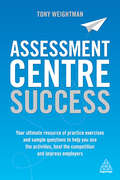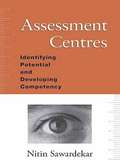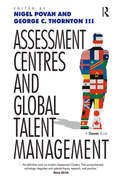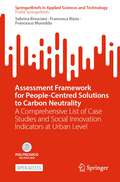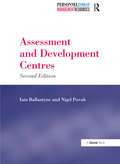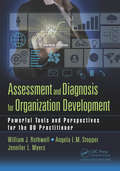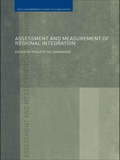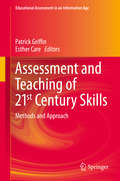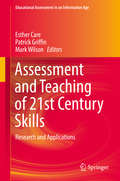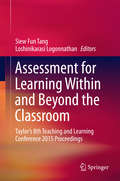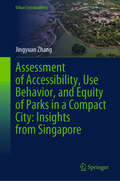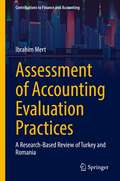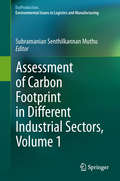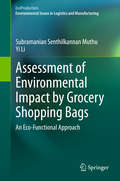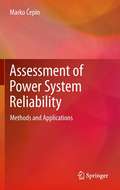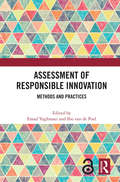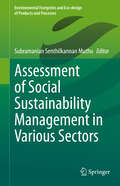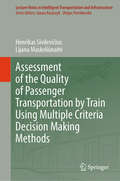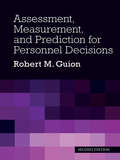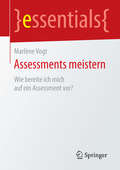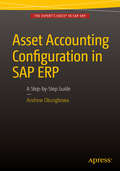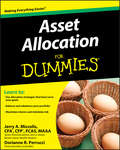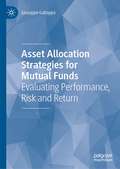- Table View
- List View
Assessment Centre Success: Your Ultimate Resource of Practice Exercises and Sample Questions to Help you Ace the Activities, Beat the Competition and Impress Employers
by Tony WeightmanAssessment Centre Success is your road map to mastering the skills, exercises and challenges that you'll be faced with when trying to secure that prized job offer. An Assessment Centre can be daunting: you are likely to face a full day of challenging exercises, tests and skilled competitors. However, with the right level of practice and preparation, you will be able to confidently tackle whatever employers may throw at you.Written by experienced Assessment Centre planner, Tony Weightman, Assessment Centre Success contains a bank of practice exercises and insider tips to help you succeed. Individual exercises are covered, including how to deliver good presentations, reports, interviews and analysis under pressure as well as group exercises such as problem solving and team presentations. Expert guidance on how to demonstrate the key skills employers are looking for helps you understand how to show yourself in the best possible light under challenging circumstances: including leadership, team work, industry knowledge, keeping calm under pressure, decision making, analytical skills, confidence and communication skills.
Assessment Centres
by Nitin SawardekarToday`s knowledge-driven organisations recognise the importance of managing competence strategically. To harness potential and develop competencies, a technique which organisations are increasingly resorting to is--assessment centres. In this lucid book, the author covers in detail the evolution of the technique and takes the reader through the entire procedure of employing assessment centre in an organisation which includes: - The identification of competencies - Design parameters - Approaches - The conduct of assessment centres
Assessment Centres and Global Talent Management
by George C. IiiGlobalization, innovation, market share, identifying visionary leaders and, particularly, talent management ...are just some of the issues that benefit from using assessment and development centres. Assessment Centres and Global Talent Management focuses on topics that influence the design of the assessment centre in terms of the competencies being assessed, the exercises that are used and the nature of the event, so that they can deliver what is required; often to change organizational culture and values. Practical examples and case studies are sprinkled throughout the book as international contributors explore cross-cultural implications, and consider how the design, development and use of assessment centres should be adapted to different cultures. Some of the world's leading researchers and practitioners outline their research into new applications for assessment centre methods, showing how they have used it to design and implement specific assessment and development centres. This is a book from which practitioners can see how science informs good practice, and scholars will find the 32 chapters a rich source of ideas for conducting research into emerging issues in the field.
Assessment Framework for People-Centred Solutions to Carbon Neutrality: A Comprehensive List of Case Studies and Social Innovation Indicators at Urban Level (SpringerBriefs in Applied Sciences and Technology)
by Francesca Rizzo Sabrina Bresciani Francesco MuredduThis open access book presents a catalogue of over one thousand indicators which can be used by cities' public administrators to monitor and evaluate social innovation action plans to support people-centred, collaborative or co-designed solutions to lower carbon emissions. Indicators are clustered according to a framework of social innovation solutions for climate neutrality at city level, developed by merging top-down academic knowledge with bottom-up pragmatic case studies. There is currently limited guidance on how to embed social innovations in their cities’ action plans with the aim of reaching climate neutrality, and on how to assess the progress and impacts of such people-centred projects in cities. The book addresses this gap and is thus relevant for scholars in the field of policy-making and design, as well as cities’ transition teams, policymakers and consultants. Based on the work developed within the EU-funded project NetZeroCities, intervention logics are provided for each of the ten categories of action, with related indicators clustered by category and evaluation criteria (effectiveness, efficiency, relevance, replicability, and scalability). Guidelines to implement the framework support city administrators in defining steps they need to follow to apply the indicators to their local case, making social innovation a crucial lever for accelerating systemic transformation.
Assessment and Development Centres
by Nigel Povah Iain BallantyneSince the first edition of this book, the level of interest and the varied forms of assessment and development centres have mushroomed. Iain Ballantyne and Nigel Povah's book looks at the entire process, from the underlying concepts to the most effective methods of validation - not forgetting the organizational politics involved. The main objectives of the book are: ¢ to establish a thorough understanding of the principles and practice of assessment and development centres; ¢ to provide sufficient knowledge to enable practitioners to run their own events in a professional manner; ¢ to help readers to recognise when they may need to call on outside expertise, and ¢ to equip readers to ask pertinent questions of any prospective advisers. This second edition includes guidance to reflect the significant developments within the technology, along with further advice on quality control, process improvements and further refinements to the increasingly popular development centre concept. Assessment and Development Centres represents a practical approach which is sure of a warm welcome from HR professionals.
Assessment and Diagnosis for Organization Development: Powerful Tools and Perspectives for the OD Practitioner
by William J Rothwell Angela L.M. Stopper Jennifer L. MyersAlthough the theory and methods of organization development (OD) assessment and diagnosis have been covered in other books, there is a lack of practitioner-focused guides that introduce real-world case studies and tools rooted in the methodology. This book will fill that gap, providing practical perspective and insight from practitioners and consultants currently practicing OD assessment and diagnosis. Organization Development (OD) differs from management consulting in that OD assessment and diagnosis is not a prescriptive consulting engagement. Instead, OD methods include engaging clients to build change leadership initiatives customized to their particular situation. OD is not about a consultant telling a client company what to do. It is about an OD professional guiding client companies on their journey towards the best end point for their particular situation. This book will address that journey. The theory and foundational principles of OD are covered, but the primary focus is on providing practical applications to businesses. While the book is grounded in sound academic theory, its strength is its practitioner-focused methodology containing vignettes and tools that individuals can use to help guide the assessment and diagnosis efforts in their own or their client organizations.
Assessment and Measurement of Regional Integration (Routledge Studies in Globalisation)
by Philippe De LombaerdeA unique examination of why the quest for global free trade often forgets that trade liberalization is organized regionally rather than multilaterally. There are now more than 250 regional integration initiatives and this number is steadily increasing. This trend raises a key question: What is the impact of regional integration, both for the countries involved and for those excluded from regional integration schemes? Using a combined economic, political science and scientific approach, this book explores how regional integration can be measured and evaluated and delivers comprehensive answers. It looks at the methodological problems involved in designing monitoring tools for regional integration in a systematic way and makes a number of concrete suggestions for designing and organising systems of indicators of regional integration. It also offers a critical overview of available indicators and tools and presents crucial new monitoring instruments. This book will be of great interest to students and researchers of international relations and economics as well as policy makers and professionals within international and regional organizations.
Assessment and Teaching of 21st Century Skills: Methods and Approach (Educational Assessment in an Information Age)
by Patrick Griffin Esther CareThis second volume of papers from the ATC21STM project deals with the development of an assessment and teaching system of 21st century skills. Readers are guided through a detailed description of the methods used in this process. The first volume was published by Springer in 2012 (Griffin, P. , McGaw, B. & Care, E. , Eds. , Assessment and Teaching of 21st Century Skills, Dordrecht: Springer). The major elements of this new volume are the identification and description of two 21st century skills that are amenable to teaching and learning: collaborative problem solving, and learning in digital networks. Features of the skills that need to be mirrored in their assessment are identified so that they can be reflected in assessment tasks. The tasks are formulated so that reporting of student performance can guide implementation in the classroom for use in teaching and learning. How simple tasks can act as platforms for development of 21st century skills is demonstrated, with the concurrent technical infrastructure required for its support. How countries with different languages and cultures participated and contributed to the development process is described. The psychometric qualities of the online tasks developed are reported, in the context of the robustness of the automated scoring processes. Finally, technical and educational issues to be resolved in global projects of this nature are outlined.
Assessment and Teaching of 21st Century Skills: Research and Applications (Educational Assessment in an Information Age)
by Mark Wilson Patrick Griffin Esther CareRapid--and seemingly accelerating--changes in the economies of developed nations are having a proportional effect on the skill sets required of workers in many new jobs. Work environments are often technology-heavy, while problems are frequently ill-defined and tackled by multidisciplinary teams. This book contains insights based on research conducted as part of a major international project supported by Cisco, Intel and Microsoft. It faces these new working environments head-on, delineating new ways of thinking about '21st-century' skills and including operational definitions of those skills. The authors focus too on fresh approaches to educational assessment, and present methodological and technological solutions to the barriers that hinder ICT-based assessments of these skills, whether in large-scale surveys or classrooms. Equally committed to defining its terms and providing practical solutions, and including international perspectives and comparative evaluations of assessment methodology and policy, this volume tackles an issue at the top of most educationalists' agendas.
Assessment for Learning Within and Beyond the Classroom: Taylor’s 8th Teaching and Learning Conference 2015 Proceedings
by Siew Fun Tang Loshinikarasi LogonnathanThese conference proceedings focus on "Assessment for Learning: Within and Beyond the Classroom" in recognition of the power of assessment for learning as a way of boosting student performance. They explore the breadth, depth and quality of the best models and practices, strategies, lessons learnt and discuss cases of successful implementation of assessment within the classroom and beyond, including the virtual space. They also provide fertile ground for stimulating and comparing responsive assessment approaches and practices in relatively new areas of assessment such as graduate capability assessment in view of the need for educational institutions to evidence graduate employability.
Assessment of Accessibility, Use Behavior, and Equity of Parks in a Compact City: Insights from Singapore (Urban Sustainability)
by Jingyuan ZhangThis book presents methodological and empirical advancements in evaluating the accessibility, use demand and behavior, and equity of urban parks. A comparative analysis was conducted across four planning areas in Singapore, a renowned compact city. An innovated conceptual framework was devised to effectively measure residents’ physical and perceived accessibility to their most often visited parks, explore their perceptional park use demand and behavior, as well as to evaluate the spatial equity of park distribution. This was achieved through spatial analysis combined with a household perception study involving 597 participants. The target audience for this book includes undergraduate and graduate students interested in accessibility, behavior and equity analysis, researchers focusing on spatial and behavioral analysis of urban public facilities, and practitioners involved in the planning and management of urban parks and greenspaces.
Assessment of Accounting Evaluation Practices: A Research-Based Review of Turkey and Romania (Contributions to Finance and Accounting)
by Ibrahim MertThe book describes the historical evolution and development of accounting theories and principles. Value and valuation have been reviewed extensively. The author provides a detailed comparison between historic and fair value accounting. A comprehensive review of the literature and researchers’ opinions about measurement, fair value, and historical cost value will enable the readers to understand the concepts in detail. Additionally, the book includes case studies evaluating the accounting practices in Turkey and Romania to illustrate how these concepts are implemented in practice. The reader will obtain a good understanding of the local nationalized accounting systems, and up to what extent countries have adapted to IFRS. The books discusses the usage of IT tools in accounting and analyses the impact of information technology such as big data, artificial intelligence, and data analytics in the field of accounting.
Assessment of Carbon Footprint in Different Industrial Sectors, Volume 2 (EcoProduction)
by Subramanian Senthilkannan MuthuFollowed by the previous part (Volume-1), Volume-2 of carbon footprint assessment book deals with the assessment of carbon footprint in different other sectors, which were not dealt in the first part. Attention on Carbon footprint is growing day-by-day from the public, government and media. Certainly it is one of the most important topics in the agenda of every nation, which is trying its best to reduce its carbon footprint to the maximum possible extent. Every manufacturing industry or sector would like to reduce the carbon footprint of its products and consumers are looking for the products which emit lower carbon emissions in their entire life cycle. Assessment of Carbon footprint for different products, processes and services and also carbon labeling of products have become familiar topics in the recent past in various industrial sectors. Every industry has its unique assessment and modeling techniques, allocation procedures, mitigation methods and labeling strategies for its carbon emissions. With this background, volume two of this book has been framed with dedicated chapters on carbon footprint assessment on various industrial sectors, apart from the ones covered in Volume 1. In each chapter, details pertaining to the assessment methodologies of carbon footprint followed in a particular industry, challenges in calculating the carbon footprint, case studies of various products in that particular industry, mitigation measures to be followed to trim down the carbon footprint, recommendations for further research are discussed in detail.
Assessment of Environmental Impact by Grocery Shopping Bags: An Eco-Functional Approach (EcoProduction)
by Yi Li Subramanian Senthilkannan MuthuThis book reviews the manufacturing processes of different shopping bags used for grocery purposes, life cycle impacts, modelling of life cycle impacts, carbon and eco-footprints in different countries, consumption of shopping bags in different countries, consumer behaviour of shopping bags in various countries and its relation to eco-impact, assessment of functionality of shopping bags, concept and framework of eco-functional assessment of shopping bags, biodegradation of shopping bags, etc.
Assessment of Power System Reliability: Methods and Applications
by Marko ČepinThe importance of power system reliability is demonstrated when our electricity supply is disrupted, whether it decreases the comfort of our free time at home or causes the shutdown of our companies and results in huge economic deficits. The objective of Assessment of Power System Reliability is to contribute to the improvement of power system reliability. It consists of six parts divided into twenty chapters. The first part introduces the important background issues that affect power system reliability. The second part presents the reliability methods that are used for analyses of technical systems and processes. The third part discusses power flow analysis methods, because the dynamic aspect of a power system is an important part of related reliability assessments. The fourth part explores various aspects of the reliability assessment of power systems and their parts. The fifth part covers optimization methods. The sixth part looks at the application of reliability and optimization methods. Assessment of Power System Reliability has been written in straightforward language that continues into the mathematical representation of the methods. Power engineers and developers will appreciate the emphasis on practical usage, while researchers and advanced students will benefit from the simple examples that can facilitate their understanding of the theory behind power system reliability and that outline the procedure for application of the presented methods.
Assessment of Responsible Innovation: Methods and Practices
by Emad YaghmaeiResponsible Innovation encourages innovators to work together with stakeholders during the research and innovation process, to better align the outcomes of innovation with the values, needs and expectations of society. Assessing the benefits and costs of Responsible Innovation is crucial for furthering the responsible conduct of science, technology and innovation. However, there is until now only limited academic work on Responsible Innovation assessment. This book fills this lacuna. Assessment of Responsible Innovation: Methods and Practices presents tools for measuring, monitoring, and reporting upon the Responsible Innovation process and the social, environmental, scientific, and economic impacts of innovations. These tools help innovators to mitigate risk and to strengthen their strategic planning. This book aligns assessment tools and practices with the UN Sustainable Development Goals (SDGs). The prospects as well as the limitations of various Responsible Innovation assessment approaches and tools are discussed, as well as their applicability in various industry contexts. The book brings together leading scholars in the field to present the most comprehensive review of Responsible Innovation tools. It articulates the importance of assessment and value creation, the different metrics and monitoring systems that can be deployed and the reporting mechanisms, including the importance of effective communication.
Assessment of Social Sustainability Management in Various Sectors (Environmental Footprints and Eco-design of Products and Processes)
by Subramanian Senthilkannan MuthuThis volume presents a variety of case studies detailing how imperatives of social sustainability are handled in several industries. The first chapter written by the volume editor provides context for social sustainability and explains how the following chapters fit together. The following five chapters detail cases from the textile industry, technology firms, agriculture, and the healthcare industry.
Assessment of the AHRQ Patient Safety Initiative
by Michael D. Greenberg Cheryl L. Damberg Donna O. Farley Melony E. Sorbero M. Susan RidgelyUpdates the policy context of the Agency for Healthcare Research and Quality (AHRQ) patient safety initiative; documents the current priorities and activities undertaken; and assesses contributions of health information technology projects and dissemination actions to support adoption of evidence-based safe practices. Discusses implications for future AHRQ policy, programming, and research; suggests ways to strengthen AHRQ activities.
Assessment of the Quality of Passenger Transportation by Train Using Multiple Criteria Decision Making Methods (Lecture Notes in Intelligent Transportation and Infrastructure)
by Henrikas Sivilevičius Lijana MaskeliūnaitėThis book presents a study of the rail travel process, where passengers under normal (non-emergency) conditions choose their own itinerary considering the offered timetable, travel expenses, comfort, potential risks, quality of service and other factors. Upon identifying many criteria that are critical for this kind of transport, the authors show how to use them to generate a multicriteria mathematical models to calculate the quality of the travel. The model is used to compare road, rail, and air transport alternatives against each other. The results are presented, together with the technical details to build up the model. This book is intended for students, researchers and decision makers working on the development and quality assessment of rail transport.
Assessment of the Risk of Amazon Dieback
by Walter Vergara Sebastian M. ScholzThe Amazon basin is a key component of the global carbon cycle. Not only is the old-growth rainforests in the basin huge carbon storage with about 120 billion metric tons of carbon in their biomass, but they also process annually twice the rate of global anthropogenic fossil fuel emissions through respiration and photosynthesis. In addition, the basin is the largest global repository of biodiversity and produces about 20 percent of the world's flow of fresh water into the oceans. Despite the large CO2 efflux from recent deforestation, the Amazon rainforest is still considered to be a net carbon sink or reservoir because vegetation growth on average exceeds mortality. However, current climate trends and human-induced deforestation may be transforming forest structure and behavior. Amazon forest dieback would be a massive event, affecting all life-forms that rely on this diverse ecosystem, including humans, and producing ramifications for the entire planet. Clearly, with changes at a global scale at stake, there is a need to better understand the risk, and dynamics of Amazon dieback. Therefore, the purpose of the book is to assist in understanding the risk, process and dynamics of potential Amazon dieback and its implications.
Assessment, Measurement, and Prediction for Personnel Decisions: Second Edition
by Robert M. GuionRobert Guion’s best seller is now available in this new second edition. This noted book offers a comprehensive and practical view of assessment –based personnel decisions not available elsewhere in a single source. This edition more frankly evaluates the current research and practice and presents challenges that will change the basic thinking about staffing systems. This new edition suggests new directions for research and practice, includes emphasis on modern computers and technology useful in assessment, and pays more attention to prediction of individual growth and globalization challenges in the assessment process. The book will be of interest to faculty and students in Industrial Organizational psychology, human resource management and business. IO psychologists in private business and public sector organizations who have responsibilities for staffing and an interest in measurement and statistics will find this book useful.
Assessments meistern: Wie bereite ich mich auf ein Assessment vor? (essentials)
by Marlène VogtDieses Essential zeigt Ihnen, was Sie in einem Assessment erwartet und wie Sie sich darauf vorbereiten können. Zu diesem Zweck wird dargestellt, wie ein Assessment typischerweise aufgebaut ist, mit welchen Aufgaben und Übungen Sie konfrontiert sein werden und wie Sie diese am besten meistern können. Darüber hinaus erhalten Sie Anregungen, wie Sie mithilfe von klaren Zielformulierungen und einer ,,bewussten Haltung" während des Assessments Ihr Bestes geben und Ihre Kompetenzen unter Beweis stellen können.
Asset Accounting Configuration in SAP ERP: A Step-by-Step Guide
by Andrew OkungbowaIn this book, noted expert Andrew Okungbowa explains SAP Asset Accounting (FI-AA) in SAP-ERP, including its associated business benefits, and guides you through the considerable complexities of SAP-ERP configuration. Using FI-AA for fixed asset management enables you to manage assets in multinational companies across a broad range of industries and produce reports to meet various needs in line with legal requirements. Configuring SAP-ERP can be a daunting exercise, however, and there are few resources that address these issues. Asset Accounting Configuration in SAP ERP fills that resource gap by covering the major aspects of SAP FI-AA for anyone with SAP experience and the basic accounting knowledge and bookkeeping skills necessary to apply configuration. It provides configuration explanations in the simplest forms possible and provides step-by-step guidance with illustrations and practical examples. What you'll learn The details of the FI-AA syllabus How to configure FI-AA accounting in SAP How to integrate FI-AA accounting with other SAP modules How to transfer asset data How to prepare for startup and perform periodic processing Who this book is for The key target audience for this book includes SAP consultants, developers, accountants, support organizations and beginners. It is also a resourceful learning manual for universities and institutions whose curricula covers SAP-ERP Asset Accounting. Table of Contents Chapter 1 - Customizing Organizational Structures in SAP Asset Accounting (FI-AA) Chapter 2 - Integrating Asset Accounting with the General Ledger (FI-GL) Chapter 3 - Valuation of Fixed Assets Chapter 4 - Depreciation Chapter 5 - Special Valuation Chapter 6 - Customizing Master Data Chapter 7 - Customizing Transactions Chapter 8 - Customizing Validation and Substitution Chapter 9 - Reporting with Asset Accounting Chapter 10 - Transferring Asset Data Chapter 11 - Preparing for Production Startup Chapter 12 - Processing Periodic Programs Appendix A - Useful General Ledger Accounts Appendix B - Useful Transaction Codes
Asset Allocation For Dummies
by Jerry A Miccolis Dorianne PerrucciAn easy-to-understand how-to guide to the single most important thing you can do in investing - choosing and mixing your assets successfully. You don't need to be an expert analyst, a star stock-picker, or a rocket scientist to have better investment results than most other investors. You just need to allocate your assets in the right way, and have the conviction to stick with that allocation. The big secret behind asset allocation - the secret that most sophisticated investors know and use to their benefit - is that it's really not all that hard to do. Asset Allocation For Dummies serves as a comprehensive guide to maximizing returns and minimizing risk - while managing taxes, fees and other costs - in putting together a portfolio to reflect your unique financial goals. Jerry A. Miccolis (Basking Ridge, NJ), CFA®, CFP®, FCAS, MAAA is a widely quoted expert commentator who has been interviewed in The New York Times and the Wall Street Journal, and appeared on CBS Radio and ABC-TV. He is a senior financial advisor and co-owner of Brinton Eaton Wealth Advisors (www. brintoneaton. com), a fee-only investment management, tax advisory and financial planning firm in Madison, N. J. Dorianne R. Perrucci (Scotch Plains, NJ) is a freelance writer who has been published in The New York Times, Newsweek, and TheStreet. com, and has collaborated on several financial books, including I. O. U. S. A, One Nation, Under Stress, In Debt (Wiley, 2008).
Asset Allocation Strategies for Mutual Funds: Evaluating Performance, Risk and Return
by Giuseppe GalloppoThis book offers an overview of the best-working strategies in the field of equity and fixed income mutual fund-based portfolio management. This timely research considers different market conditions, such as global financial crises, across various geographical regions such as the USA and Europe. Combining academic and practical findings, the author presents a practitioner perspective on mutual fund-based portfolio strategies, appealing not only to finance scholars but also professionals within the asset management industry. This book synthesizes a large part of the academic research to date on the mutual fund industry by drawing from the most widely cited academic journals. The author makes a systematic use of numerical examples to facilitate the understanding of Investment themes organized around several important topics: size, diversification, flows, active management, volatility, performance persistence and rating.
